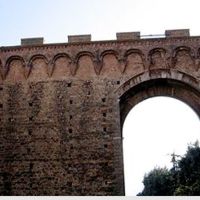
Affidati ad un Internet Provider affidabile:
Anyweb, a Pisa dal 1996!

On top of the hill overlooking the village of Torri in Sovicille, lies the prehistoric settlement of the Neolithic Sienavecchia. The old Siena name seems actually goes back to the ancient multicenter team of Etruscan Saenae.
According to legend, Romulus sent his Camellio and Montorio captains to win Ascanio (or Aschio) and Senio, supposed sons of Remus and the founding of a settlement of Saenae; Camellio, for its part, founded the Cammollia nucleus [8] and Montorio founded Castelmontorio. Instead, the nearby village of Brenna (Sovicille), according to tradition, named after the famous chief of the Brenno Gauls, who reached the region after being expelled from Rome in the early fourth century BC. Historical records describe us instead of Siena it founded as a Roman colony at the time of Emperor Augustus, known as Saena Iulia.
Within the historic center of Siena we were found of Etruscan sites, which may suggest the founding of the city by the Etruscans. According to authoritative studies in fact the name Siena can be derived from the Etruscan noble Saina / Seina, epigraphically amounted to Montalcino, Chiusi and Perugia.
The first known document of the Siena community dates back to 70: Senator Manlio Patruito reported in Rome that he was beaten and ridiculed with a mock funeral during his official visit to Saena Iulia, small military colony of Tuscia. The Roman Senate decided to punish the main perpetrators and severely recall the Sienese to a greater respect for the Roman authorities.
High Middle Ages did not have documents that can illuminate around the cases of civilian life in Siena. Is there any news about the establishment of the bishop and the diocese, especially the dispute between the Bishop of Siena and Arezzo, because the boundaries of the judicial area of each: matters in which the Lombard king Liutprand intervened, pronouncing judgment in favor of Arezzo's diocese. But the Sienese were not satisfied and therefore in 853, when Italy passed from the Lombard domination in the frank, succeeded in obtaining the annulment of the judgment issued by King Liutprand. It seems that at the time of the Lombards, Siena was governed by a representative of the king: Gastaldo who was later replaced by an imperial count after the coronation of Charlemagne. The first count of which have concrete news was Winigi, son of Ranieri, 867. After 900 reigned in Siena Emperor Louis III, whose reign did not last so long, since 903 in the chronicles tell of a return to power of the accounts under the new government of King Berengario.
Siena is found in the tenth century at the center of important trade routes that led to Rome and, thanks to what became an important medieval city. In the twelfth century, the city was equipped with communal and consular type, it begins to expand its territory and tightens the first alliances. This situation of both political and economic, led Siena to fight for the northern domains of Tuscany, against Florence. From the first half of the twelfth century onwards Siena prospered and became an important commercial center, keeping a good relationship with the Papal States; the Sienese bankers were a reference point for the authorities in Rome, who turned to them for loans or financing.
At the end of the twelfth century Siena, supporting the Ghibelline cause (even if there were, the Sienese family of the Guelph party, in tune with Florence), he found himself again against Florence on the Guelph: famous is the victory over the Tuscan Guelph in the battle of Montaperti, 1260, mentioned by Dante Alighieri. But after a few years the Sienese were defeated in the battle of Colle Val d'Elsa, in 1269, which later led, in 1287, the rise of the Government of the Nine, part of Guelph. Under this new government, Siena reached its peak, both economically and culturally.
After the plague of 1348, began the slow decline of the Republic of Siena, which in any case did not preclude the road to the territorial expansion of Siena, that until the day of the fall of the Republic comprised a third of Tuscany. The end of the Sienese Republic, perhaps the only Western state to implement a pure democracy in favor of the people, took place April 21, 1555, when the city, after a siege of more than a year, had to surrender exhausted by hunger, the empire of Charles V, backed by the Medici, who subsequently ceded in fief the territory of the Republic to the Medici, lords of Florence, to repay the costs incurred during the war. Once again the citizens of Siena were able to stand up to an emperor, that only thanks to their enormous resources could bend the fierce resistance of this small republic and its citizens.
After the fall of the Sienese Republic a few guided also by the exiled Florentine Piero Str
